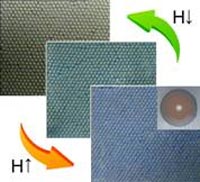Magnetic Chameleons

Chinese researchers have created microscopic capsules that change color when a magnetic field is applied. When the capsules are collected into an array, magnetic fields can be used to create colored patterns on an extremely small scale.
Many animals use tiny physical changes at their skin or surface to alter their color. Chameleons do this by pumping slightly different amount of dye into the surface of their skins. Other animals, such as some beetles, fish and birds, have special arrays of light-reflecting cells that are moved apart very slightly by the injection or removal of a fluid, or by tiny stretching of their skin. These nanometer changes in spacing are enough to change the wavelength of light that is reflected and hence the color that we see.
Scientists have been able to replicate this effect to some extent using regular clusters of tiny spheres known as colloidal crystals. The spacing between the centres of the spheres determines the wavelength of light that is reflected and, hence the color of the crystal. Simple actions such as adding fluid (as described above) or swelling the size of the particles have been used to change the color.
If the spheres used are magnetic, then a magnetic field can be used to control the spacing between them, and, of course, the color. This phenomenon has been shown previously, but stable systems were not created and the color seen was very dependent on viewing angle.
Now, as described in the journal Advanced Functional Materials, Zhongze Gu and coworkers at the Southeast University in Nanjing have created stable droplets of particles whose color can be tuned through a wide range and which does not depend on where the viewer stands.
Their breakthrough was to encapsulate clusters of magnetic spheres in a liquid within tiny, transparent resin beads. The beads are highly uniform and could be used as individual pixels in a display. Applying different magnetic fields causes the spheres within the capsules to move further apart or closer together, resulting in different colors. The picture shows the effect of applying different magnetic fields.
Another clever idea of Gu and his team was to use automated technology to create the capsules. Uniform sizes and composition are required if such materials are to be used as displays, and this was achieved by using microfluidic techniques, where reactions occur continuously as ingredients travel along the narrow channels of a very small-scale reactor. Tuning the flow rates of various reactants easily controls the capsulesf size, shell thickness and shape.
The scientists are proud of their work and imagine that it could be adapted to be used with electronic magnetic fields, using the full potential of the tiny scale of the microcapsules and leading to gmore complex and interesting patterns.h
C. Zhu, W. Y. Xu, L. S. Chen, W. D. Zhang, H. Xu, and Z. Z. Gu, gMagnetochromatic Microcapsule Array for Displayh, Adv. Funct. Mater. 2011; DOI: 10.1002:adfm.201002296.
Contact:
Prof. Zhongze Gu
State Key Laboratory of Bioelectronics
Sipailou 2, Nanjing, P. R. China
EmailFgu@seu.edu.cn
Tel/Fax: +86-25-83795635
Media Contact
All latest news from the category: Materials Sciences
Materials management deals with the research, development, manufacturing and processing of raw and industrial materials. Key aspects here are biological and medical issues, which play an increasingly important role in this field.
innovations-report offers in-depth articles related to the development and application of materials and the structure and properties of new materials.
Newest articles

Time to Leave Home? Revealed Insights into Brood Care of Cichlids
Shell-dwelling cichlids take intense care of their offspring, which they raise in abandoned snail shells. A team at the Max Planck Institute for Biological Intelligence used 3D-printed snail shells to…

Smart Fabrics: Innovative Comfortable Wearable Tech
Researchers have demonstrated new wearable technologies that both generate electricity from human movement and improve the comfort of the technology for the people wearing them. The work stems from an…

Going Steady—Study Reveals North Atlantic’s Gulf Stream Remains Robust
A study by the University of Bern and the Woods Hole Oceanographic Institution in the USA concludes that the ocean circulation in the North Atlantic, which includes the Gulf Stream,…



